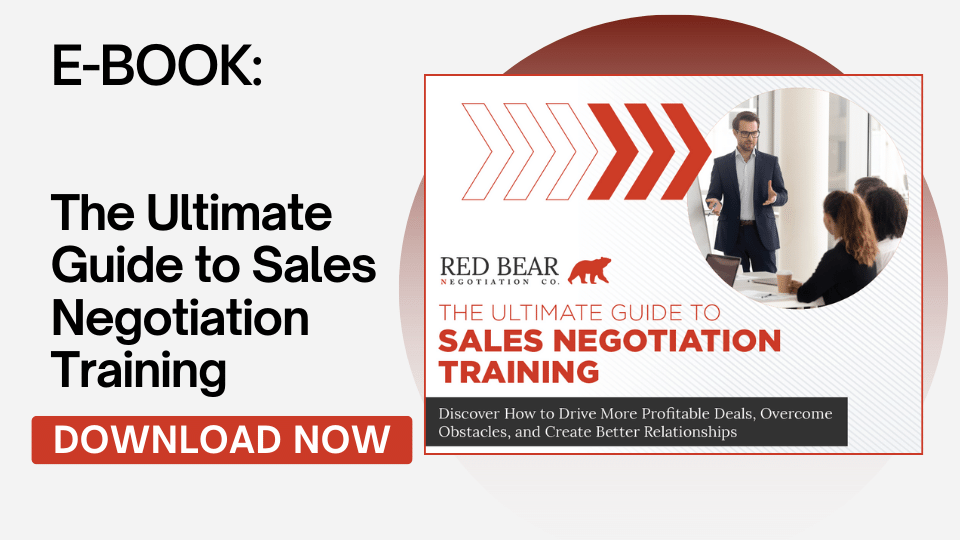Even in today’s fast-paced world of sales, the timeless art of sales negotiation remains an irreplaceable asset.
However, with changing buyer behavior and an ever-evolving digital landscape, the sales process is seeing a paradigm shift. It’s no longer just about closing the deal; it’s about fostering relationships, understanding underlying needs, and establishing trust.
Here at RED BEAR, we know the value of relationship building. It’s the difference between getting a good deal and getting dozens of good deals over the course of a decade from the same customer.
That’s why our tried and true method of building an effective negotiation strategy is utilized by over 45% of the Fortune 500.
Let’s explore some effective negotiation strategies your sales team can use to build better, more valuable relationships — all while maximizing the outcomes of your deals.
The Importance and Value of Relationship Building
Before we dive into our negotiation strategies, it’s important to understand that the best strategies help build long-term relationships, not just maximize the value of the current deal. While other training courses might focus on manipulative strategies and tactics, that’s not how you build a strong relationship.
Here at RED BEAR, we teach the principles and behaviors that drive successful negotiations.
Ultimately, at the other end of each deal is a human. Remembering that and focusing on building a long-term relationship is the key to finding success in today’s modern sales environment.
Buyers are using more and more channels during their sales journey. While in 2016, your average buyer would use five channels, that number broke into double digits in 2021 for an average of 10.
Moreover, sales professionals are getting less facetime with customers than ever before. According to Gartner research, time spent with a sales rep only makes up 17% of the B2B purchase journey. It's mission-critical that sales professionals approach each negotiation from a value-based perspective. They need to find creative and innovative ways to make a positive impact with the time they have.
But don’t think this is some new strategy; it’s based on the fundamentals of behavioral psychology.
Think of it this way: Who would you rather work with? The person looking to understand your needs and is willing to put in the effort to find win-win solutions, or the person using manipulative tactics and trying to pull the wool over your eyes?
In a world where digital technology integrates into every buyer's journey, it’s these relationship-building strategies that help drive value long after the deal wraps up. So, if you’re looking to make an impact in the sales process, what do you need to know?
“In a world where digital technology integrates into every buyer's journey, it’s these relationship-building strategies that help drive value long after the deal wraps up.”
1. How to Deal with Price Pressure
Price pressure refers to the forces and factors that influence the price of a product or service, either pushing it upwards or downwards. In sales and negotiation contexts, it typically describes the challenges and resistance that sellers face from buyers pushing for lower prices or better deals.
Dealing with price pressure can be tricky. The last thing you want is to turn the negotiation sour by employing the wrong strategies. Here are a few ways to deal with price pressure:
- Position Around Value: As soon as negotiations move to pure price and discount levels, you’re moving away from the right subject: value. Be sure to have a strong positioning theme and stick to it.
- Compare Value, Not Price: Again, move away from price. If a customer is stuck on price, try and steer the conversation toward finding out their underlying needs.
- Build Negotiating Price Into Your Proposals: Structure your deals and anticipate possible price pressure.
- Concede Slowly and Directly: Making concessions is like running a marathon. Give too much too early, and you’ll be left with too much runway and not enough energy. Concede slowly and according to plan.
2. Master Tension in Negotiations
At the heart of every negotiation lies the challenge of striking a balance between protecting one's own interests (competitive dimension) and building mutually beneficial relationships (collaborative dimension).
But, when sales professionals can balance the self-interested competitive dimension with the relationship-building collaborative dimensions, they can lead the discussion toward healthy tension and creative breakthroughs.
It’s all about using the Negotiation Behaviors effectively:
- Make Trades: Trades are a two-way street. But, when you need to break an impasse, they come in handy.
- Make Demands: Be specific and non-judgmental. Be clear about what you want, need, or expect.
- Propose Conditionally: Want to get people thinking creatively? Why not make tentative and non-specific conditions? These can help break impasses.
- Ask Open Questions: The who, what, when, and tell me more in question asking. This helps you draw out or gain information by uncovering underlying needs.
3. Use Negotiables to Satisfy Needs
In sales negotiation, understanding and leveraging negotiables can drastically transform outcomes. At its core, a negotiable is an element or item that can be adjusted, traded, or exchanged to bring value to the negotiating table.
It represents the malleability of a deal. Recognizing and maximizing the potential of negotiables can open doors to satisfying deeper needs beyond surface-level discussions.
They often fall into three main categories:
- Primary Negotiables: The agreed upon or assumed negotiables. In most situations, this is generally money.
- Alternate Negotiables: The not-so-obvious negotiables that still satisfy a need.
- “Elegant” Negotiables: Alternate Negotiables that cost you little but are highly valuable to the other party.
Let’s say a customer had a bad experience with post-purchase support with another company. Because of this, they’re looking for a lower price on your service.
Instead of lowering the price and focusing solely on the primary negotiable, you might offer assurances in your team’s commitment to post-purchase support that brings more value to the table and makes your offer more enticing.
4. Countering Tactics
The use of tactics implies manipulation, trickery, and even dishonesty.
While you may encounter tactics in negotiations, it’s important to understand the consequences of using tactics, even in response to the other party using them.
Outside the obvious ethical implications, there are often legal ones, too. Additionally, tactics can paint your team and company as manipulative and likely damage relationships.
What you want to do is employ countermeasures to tactics.
How do we use countermeasures? Well, it’s all about leveraging the Negotiation Behaviors. But you need to follow some simple steps:
- Identify the tactic being used.
- Call attention to it.
- Raise it as an issue.
- Negotiate an end to the use of the tactic using the behaviors.
Let’s say the other party uses the classic “good buy/bad guy” tactic. How can you tackle this problem? Well, you might use the Make Demands behaviors and say, “I would like the two of you to get together and work out your response, then get back to me.”
Build a Negotiation Strategy for Sustainable Success
The era of aggressive, tactics-heavy approaches to a negotiation strategy is over. With today’s informed buyers, those kinds of approaches will only lead to one thing, and that’s a bad relationship.
In its place are negotiation strategies rooted in understanding, respect, and value co-creation. RED BEAR’s human-centered approach reminds us of this core truth: Behind every negotiation is a person with aspirations, concerns, and needs.
As sales professionals, when we adopt a mindset that prioritizes relationships, we not only secure immediate deals but pave the way for future collaborations.
That’s the power of RED BEAR Negotiation Training. We don’t teach manipulative tactics or one-off strategies. We teach the fundamentals of negotiation that help your team reach win-win outcomes and build stronger, longer-lasting relationships.
Our workshops get results. Not only do we offer a 10X ROI guarantee, but for every dollar invested in our training, our clients receive, on average, $54 back — talk about value.
Ready to get started learning the same negotiation fundamentals that are used by Fortune 500 companies? Reach out to the RED BEAR team today.




